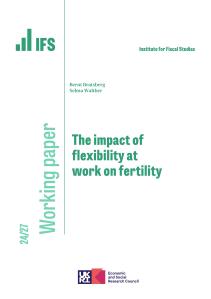From the start of April, parents in England will start to get access to the new entitlements to funded childcare announced just over a year ago. In this comment piece, we summarise what is known about the deliverability, distributional consequences and likely impacts of the new entitlements.
What are the new childcare entitlements?
England’s early years offer is increasingly centred on the ‘free entitlement’ to a funded childcare place. One goal of this policy is to support children’s development: all 3- and 4-year-olds and roughly a quarter of the most disadvantaged 2-year-olds are eligible for a part-time free entitlement place (up to 15 hours a week during term time, though families can spread these hours across more weeks).
Another aim is to support parents with the cost of childcare, and through that encourage more parents into paid work. 3- and 4-year-olds living in families where all parents are in paid work (and no parent earns more than £100,000 a year) are eligible for up to 30 hours a week of free childcare, doubling their entitlement.
In the March 2023 Budget, the government announced plans to expand this entitlement for working families to younger children. The first step is happening at the start of April: 2-year-olds in working families will be eligible for up to 15 hours a week. That offer will be extended to children 9 months and older from September this year, and by September 2025 all of these children will be eligible for up to 30 hours a week of free childcare.
How many 2-year-olds will be eligible for free childcare?
The new entitlements for 2-year-olds come in addition to existing entitlements for disadvantaged 2-year-olds, which intended to support early learning and development. While the disadvantaged entitlement used to be available for roughly the 40% most disadvantaged 2-year-olds, a decade-long freeze on eligibility criteria means that fewer than 30% of 2-year-olds now qualify.
Overall, the new entitlement for 2-year-olds in working families will cover just under half of children. Given the limited overlap with the disadvantaged entitlement, that means that around 70% of 2-year-olds will be eligible for some free childcare.
The existing, disadvantage-based entitlement clearly benefits the poorest families most. By contrast, eligibility for the new entitlements is based on parents being in paid work; this almost by definition excludes the poorest families. Indeed, we find little direct benefit from the new entitlements for the poorest third of families.
Taking both policies together, as Figure 1 shows, most families across the income distribution will soon have access to some free childcare (of course, those eligible for the work-based entitlements will benefit more in September 2025, when the entitlement doubles to 30 hours a week). The families least likely to be eligible are those just below the middle of the income distribution, where eligibility for the disadvantaged entitlement has largely dropped away but many do not meet the criteria for the work-based entitlements.
Who will start using childcare?
While April will bring a big increase in the number of parents eligible for the free entitlement, the increase in the number of children using childcare will not be nearly so large. Of the roughly three-quarters of 2-year-olds who are not eligible for the disadvantaged entitlement, around half are already using (and paying for) formal childcare. The families of many of the rest state that they have a preference for not using formal childcare (unrelated to its cost).
So for many families, the first and biggest change from these reforms will be to reduce the childcare costs they would have otherwise paid themselves. The group who are encouraged into using childcare will be much smaller. This also means that the childcare market will need to create far fewer places than the 200,000 2-year-olds the government expects to take up the new offer.
Are the new funding rates high enough?
Once the new childcare entitlements are fully rolled out, we estimate that around 80% of pre-school childcare hours in England will be funded by the free entitlement. This makes the funding rate for these hours critically important. If it is inadequate, there is a risk that providers opt out of offering the new entitlements, reduce the quality of provision, or even close altogether.
On average, funding for the new entitlements (for 2-year-olds and under-2s) is higher than the current market price of childcare. In England, parents of children in this age group pay an average of around £6.15 an hour at the moment; the average (national) funding rate through the free entitlement will be £8.35 for 2-year-olds and £11.22 for under-2s. (These rates are also much higher than historical funding for the free entitlement for 2-year-olds, which stood at £5.92 an hour at the time of the March 2023 Budget.) All else equal, this means that on average providers looking after younger children could see a significant rise in their resources.
Local authorities are required to pass on 95% of this funding to providers. This includes base funding rates as well as supplements for different types of providers (for example, maintained nursery schools or more rural providers), some central services for high-needs children, and contingency funding. This means that, for some providers, there could be a substantial difference between the notional per-hour funding rate their local authority receives from the Department for Education and the final funding rate received by the setting.
What about funding for existing entitlements?
Funding for existing entitlements has had a tumultuous history: once childcare providers’ rising costs are accounted for, average hourly funding for 3- and 4-year-olds in 2024-25 will be 12% lower than in 2012-13. As Figure 2 shows, the average funding rate for 3- and 4-year-old entitlements next year is close to the amount that parents pay on the private market (for example, for those buying additional hours of childcare).
All else equal, more generous funding for younger children plus no significant change for 3- and 4-year-olds should leave providers better off, at least for those who take children across different age groups.
How do prices and funding vary across local areas?
Costs and market prices vary a lot across local authorities (LAs); as Figure 3 shows, the market price for childcare for 2-year-olds ranges from about £4.80 (in current prices) in Wigan and Rotherham, to £11.90 an hour in Kensington and Chelsea. (The latter is a clear outlier: the next-highest market price is just over £10 in Hammersmith and Fulham.)
Since the childcare funding formula accounts for differences in area costs, the funding rate will also be higher in higher-cost areas. As Figure 3 shows, all LAs except Kensington and Chelsea are set to have funding rates higher than their market price for 2-year-olds. But for some areas, the two are much closer; for example, the funding rate in Richmond is about 40p higher than its market price, while in Greenwich the funding rate will be close to £4 higher than the market price.
Winners and losers in the funding system
Of course, costs and prices will vary quite a lot within local authorities as well as across them. This means that a funding rate close to market prices on average will mean lots of providers for whom it is less, especially in higher-cost areas. Even a funding rate that is set much higher than the average market price could still see some providers losing out.
To some extent, this is part of the intent behind the existing funding system: by setting a standard price per hour of care, the government tries to incentivise providers to deliver care efficiently at lower cost. This pushes out providers with higher costs (or encourages them to find ways to circumvent the system, such as requiring ‘voluntary’ contributions or charging other top-ups).
The challenge is that some drivers of higher costs might be socially desirable. For example, while the funding rate is adjusted for LA-wide costs, some providers within a local authority will face much higher costs (for example, because they are located in a popular neighbourhood with high rental costs). In a private market, they would have flexibility to charge higher prices if parents were willing to pay. Under a funding system, these higher-cost providers will be under greater pressure. Similarly, if adjustments for disadvantage in the funding formula do not accurately reflect the additional costs providers face for taking on more disadvantaged children, these settings will struggle more to be financially viable.
Another major difference between the funding system and the private market is how income varies by the age of the child. As Figure 2 shows, at the moment providers tend to smooth costs across ages: while care is much more expensive to deliver for younger children (for example, because of tighter restrictions on ratios between carers and children), providers often charge similar hourly amounts to each age group. By contrast, the Department for Education’s funding formula clearly aims to set funding rates to more closely represent costs at each age. For providers with very few places (such as childminders), this could introduce more volatility in income as children ‘age out’ of the more generous funding rates.
What impacts will the new entitlements have?
It is too early to tell what impacts the new entitlements will have on providers, parents and children. Research by IFS researchers into previous versions of the free entitlement concluded that a 15-hour offer was not enough to encourage parents to work. Starting school – and so receiving 30 hours per week of ‘free care’ – did increase the employment of mothers whose youngest child was affected, but it is less clear whether these estimates extend to offering free childcare rather than schooling. Starting the entitlements earlier might help parents (and particularly mothers) to return to paid work once their parental leave is done, which could have long-term benefits. But, based on the Office for Budget Responsibility’s estimates (informed by the IFS research above), we calculate that perhaps only one in six children claiming the new entitlements will have a parent who moves into paid work because of them.
The impacts on children are even harder to assess. To the extent that the new entitlements do benefit children, they will increase the gaps between children in better-off families (who will benefit) and those in poorer families (who will not). But existing international research does not tend to find big benefits for the very youngest children from starting formal childcare (though the evidence base is fairly thin).
For most parents, the most obvious and immediate benefit of the new entitlements will be to reduce their childcare expenses. With spending on the free entitlement set to more than double once the roll-out is complete, understanding the extent to which these entitlements drive wider benefits will be essential to evaluating their success.










